The festive nature of food
‘Tis the season of tradition, of woodstove warmth and food made fresh from the comforts of the kitchen. It is the season of giving thanks, of gathering together—to recall memories, to celebrate, to laugh, to eat.
As Thanksgiving fast approaches, I smile with the thought of tradition. Traditions are what help to define us as individuals. Whether or not we chose to continue those of our upbringing or create ones anew, tradition is the essence of this holiday season.
And for the essence of my family, that tradition is food. Good food.
I remember the taste of my Grandmother’s garden ripe tomatoes. She would put a dash of seasalt across them, quickly, before I sunk my teeth in and devoured the daily treat. Some of my fondest memories from childhood involved twisting and turning among the corn stalks in her yard, stepping into the greenhouse, climbing tall orchard apple trees. As a teenager, I even attempted an old recipe involving chicken and red wine. Food brings my family together.
Food is what connects me to my own heritage, and to the place where I live. With the influence of three months of living in the North Cascades, for the Masters of Education Residency, I aim to bring a new tradition to the table—that of food not only fresh from the local farm, but the woods as well.
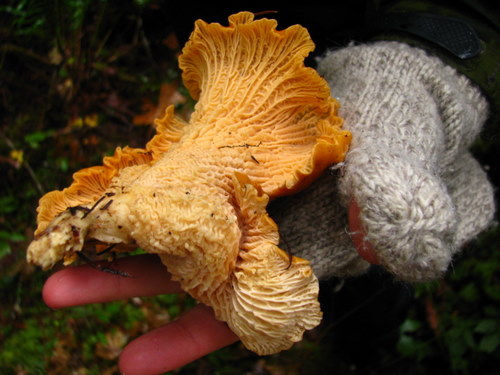 The Chanterelle, cantharellus cibarius, is a delicious edible mushroom
The Chanterelle, cantharellus cibarius, is a delicious edible mushroom
Fungus is always among us. Edible mushrooms abound in the forests of the North Cascades, especially during the fall season with heavy amounts of rain bringing them forth from beneath the duff. Though mushrooms can not be harvested in the North Cascades National Park, as it is against the law, mushroom hunting is allowed on Forest Service land along Highway 20, with certain areas procuring a lot of specific kinds of edible mushrooms.
Before going out and adding edible mushrooms to your Thanksgiving meal, it is advised to read up on the safe ways of identifying and harvesting mushrooms through such guides as David Arora’s All That the Rain Promises and More. Or, bring others into your new tradition and take a friend who knows what they are doing and learn from them in turn.
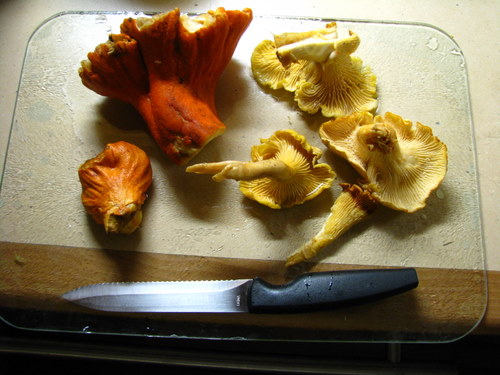 Lobster and Chanterelle mushrooms ready for cooking
Lobster and Chanterelle mushrooms ready for cooking
Some of the most common edible mushrooms that can be added to your holiday meals are the Lobster and Chanterelle mushrooms. Both have distinct flavors and unique stories. There are many recipes out there for mushrooms, but sometimes the best way to extract the essence is to saute them in some light local butter and eat immediately.
 Dry sauteing chanterelles is a great way to help preserve them for cooking
Dry sauteing chanterelles is a great way to help preserve them for cooking
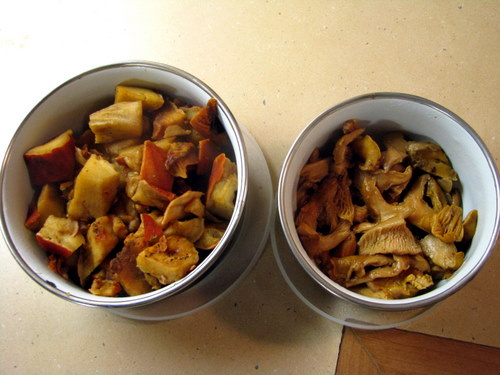 After sauteing the mushrooms, you can use immediately in almost any meal
After sauteing the mushrooms, you can use immediately in almost any meal
If you are looking for sweet treats, the berries from the Salal, an understory shrub very common to the western Washington corridor, come into their full nature in the fall. Like the shrubs themselves, the berries grow in large quantities and can be made into jams, pies and spreads, or just eaten freshly picked.
Salal, gautheria shallon, berries are full of juice and need to be mashed for jams
I have made many a salal jam jar and below is a recipe I found while browsing online for unique native edible recipes from Oregon-based nursery Bosky Dell Natives.
Salal-Oregon Grape Jelly (Yield eight 8 oz. jars)
Ingredients
- 2 cups salal juice (from approx. 2 quarts berries)
- 2 cups oregon grape juice (from approx. 2 quarts grapes)
- 1/4 cup lemon juice
- 1 package powdered pectin
- 5 cups sugar
Directions
- Extract the juice from the salal berries and oregon grapes.
- Pour the measured juices into a large 6 or 8 qt. pot.
- Add lemon juice and pectin. Stir until pectin is dissolved.
- Place over high heat and bring to a full, rolling boil.
- Add pre-measured sugar. Bring to a full, rolling boil while stirring constantly. Continue boiling and stirring for 1 minute.
- Remove from heat, skim off foam, and pour into hot, sterilized jelly jars.
- Place on lids and attach screw bands. Put in a boiling water bath for 10 minutes.
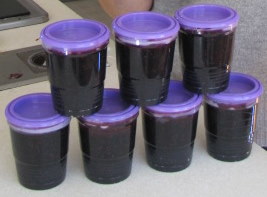 Salal berries can be used in freezer jams, jellies, pies, pretty much any sweet treat
Salal berries can be used in freezer jams, jellies, pies, pretty much any sweet treat
If venturing into the woods this winter leaves you with not enough preparation time before the Thanksgiving feast, there are many farms in the western Washington area that provide seasonal and local produce that can be great additions to your meal.
But how to find them? Washington State University’s Small Farms Team Farmer Finder is one of many different local farm directories that you can use online to find farms in the Washington and Oregon area. You can get the produce that you need while also supporting your community. North Cascades Institute buys a lot of its produce from several farms in the Skagit Valley, and they appear on the Farm Finder, including Jones Creek Farms out of Sedro Woolley and Blue Heron Farm and Nursey in Rockport.
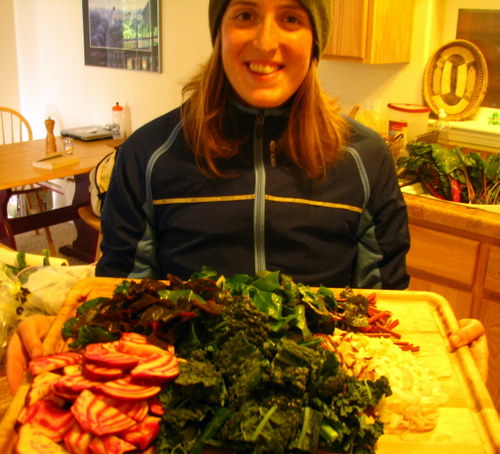 A cutting board filled with local and seasonal produce found at farmers markets
A cutting board filled with local and seasonal produce found at farmers markets
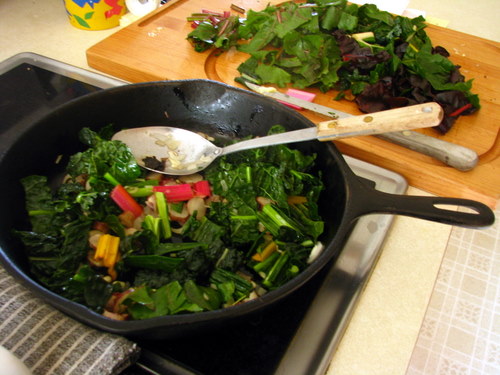 Kale, swiss chard, beet greens, shallots, sunchokes & garlic sauted with local butter
Kale, swiss chard, beet greens, shallots, sunchokes & garlic sauted with local butter
This holiday season, continue old favorites, incorporate new adventures. But always, always embrace tradition. Eat up!
Photos courtesy of Kelsi K. Franzen.


That all looks delicious. I looked at the farm finder, I kind of wish it had the list of whats in season on the individual farm page so I didn’t have to keep looking back and forth, but it looks like an awesome resource, I’ll be heading to a local farm one of these days soon.
I love your site. I look forward to reading more of your posts. Thank you!